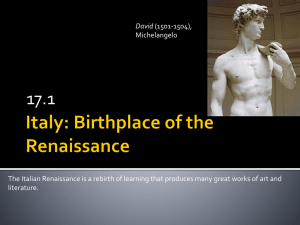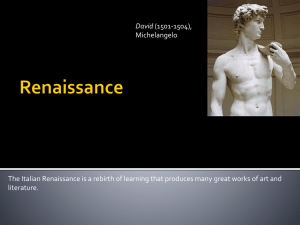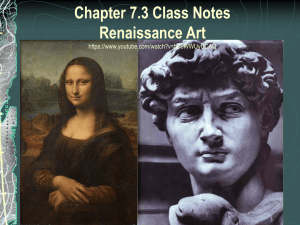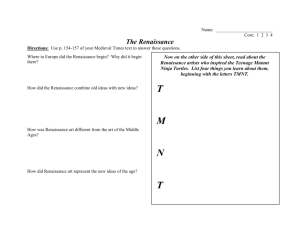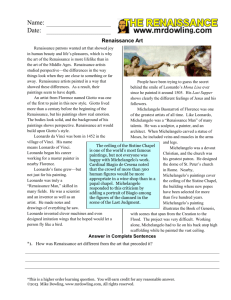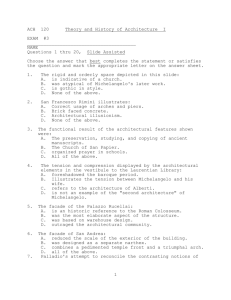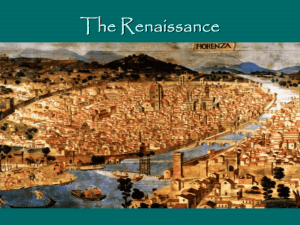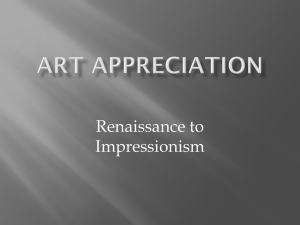chapter 17_1 italy_ birthplace of the renaissance
advertisement
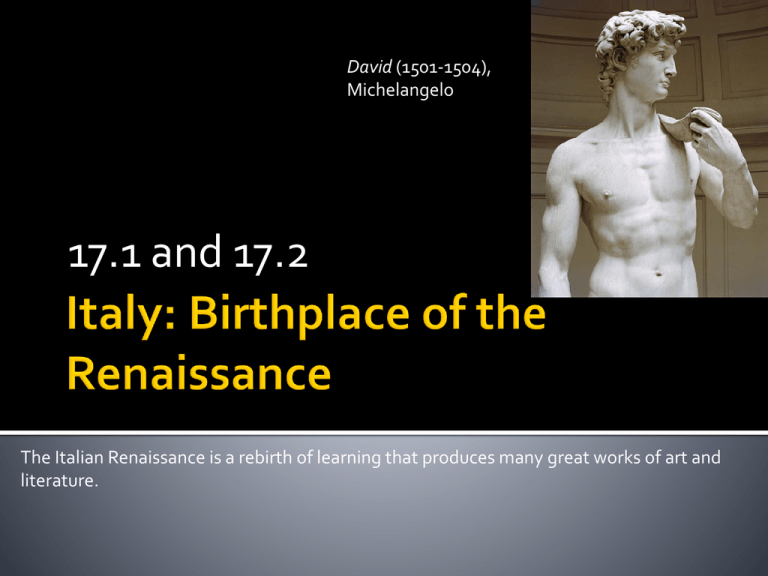
David (1501-1504), Michelangelo 17.1 and 17.2 The Italian Renaissance is a rebirth of learning that produces many great works of art and literature. The Renaissance Renaissance—an explosion of creativity in art, writing, and thought Started in northern Italy Lasted from 1300-1600 Merchants and the Medici A wealthy merchant class develops More emphasis on individual achievement Banking family, the Medici, controls Florence Great patron of the arts in Italy Looking to Greece and Rome Artists and scholars study ruins of Rome, and study Latin and Greek manuscripts Scholars move to Rome after the fall of Constantinople in 1453. Classics Lead to Humanism Humanism—intellectual movement focused on human achievements Humanists studied classical texts, history, literature, and philosophy Worldly Pleasures Renaissance society was secular—worldly Wealthy enjoyed fine food, homes, and clothes Patrons of the Arts Patron—a financial supporter of artists Church leaders spend money on artworks to beautify cities Wealthy merchants also patrons of the arts The Renaissance Man Excels in many fields: the classics, art, politics, and combat Baldassare Castiglione’s (pictured right)The Courtier (1528) teaches how to become a “universal” person The Renaissance Woman Upper-class, educated in classics, charming Expected to inspire art but not create it Isabella d’Este, patron of the artists, wields power in Mantua Artistic Styles Change Artists use realistic style copied from classical art, often to portray religious subjects Painters use perspective—a way to show three dimensions on canvas Realistic Painting and Sculpture Realistic portraits of prominent citizens Sculpture shows natural postures and expressions The biblical David is a favorite subject among sculptors (although he looks more like a classical Greek) Portrait painted after 1535 of Michelangelo at the age of 60 by Jacopino del Conte The novel and film The Agony and the Ecstasy is about him painting the Sistine Chapel for Pope Julius II. Photo of the ceiling of the Sistine Chapel The Creation of Adam by Michelangelo, found of the ceiling of the Sistine Chapel Michelangelo’s The Last Judgment in the Sistine Chapel Leonardo, Renaissance Man Leonardo da Vinci— painter, sculptor, inventor, scientist Paints one of the bestknown portraits in the world: the Mona Lisa Famous religious painting: The Last Supper Left: Mona Lisa Above: The Last Supper THE VITRUVIAN MAN STUDIES OF A FETUS FROM LEONARDO'S JOURNALS INVESTIGATING THE MOTION OF THE ARM ORGANS OF A WOMAN’S BODY Design of a flying machine based on bat’s wings Raphael Advances Realism Raphael Sanzio, famous for his use of perspective Favorite subject: the Madonna and child Famous painting: School of Athens New Trends in Writing Writers use the vernacular—their native language Self-expression or to portray individuality of the subject Petrarch and Boccaccio Francesco Petrarch, humanist and poet; woman named Laura is his muse Boccaccio is best known for the Decameron, a series of stories Machiavelli Advises Rulers Niccolo Machievelli, author of a political guidebook, The Prince The Prince examines how rulers can gain and keep power 1450…. Population rebounds from the Black Death and the destructive Hundred’s Year War ends in 1453 Italian Renaissance ideas spread to the North and mingle with the northern traditions creating a renaissance with its own style. Albrecht Durer (German) creates art that is richer and more common based than the Italian art but rich in colors and themes Jan van Eyck (Dutch) paints works that are realistic in details and show great individuality of the subjects. Humanists tried to influence society with Christian values. Desiderius Erasmus of Holland and Thomas More of England. More writes Utopia about an imaginary place where greed, corruption, and war have been wiped out. Christian Humanist believed women should be educated, founded schools for women 1558 Elizabeth becomes Queen of England after the death of her half sister Mary “ Bloody Mary” both are daughters of King Henry VIII As a women can be in here age she was highly educated and skilled in art, music, literature, and languages One of the most famous playwrites and writers in history He used the classics and drew on them for ideas and inspiration. He is know to have created more words to the English language then anyone else Many of his characters show the flaws in humans Johann Gutenberg and the Printing Press Improved on the idea of the Chinese around 1440 he designed a machine that would reproduce an entire page of a work. Books could now be printed quickly and cheaply First religious books (Bible) then others works. This increased access to books inspires literacy in the general popualtion The Arts Art drew on the style and techniques of classical Greece and Rome Portrayed art in a more realistic manner Artists created work that was more secular in nature Writers began use of the vernacular Art praised individual acheivement Printing made information more available Increased the desire to learn and literacy Lead to an era of expanded discoveries Christian Humanists tried to reform society People began to question practices of religion, and politics
